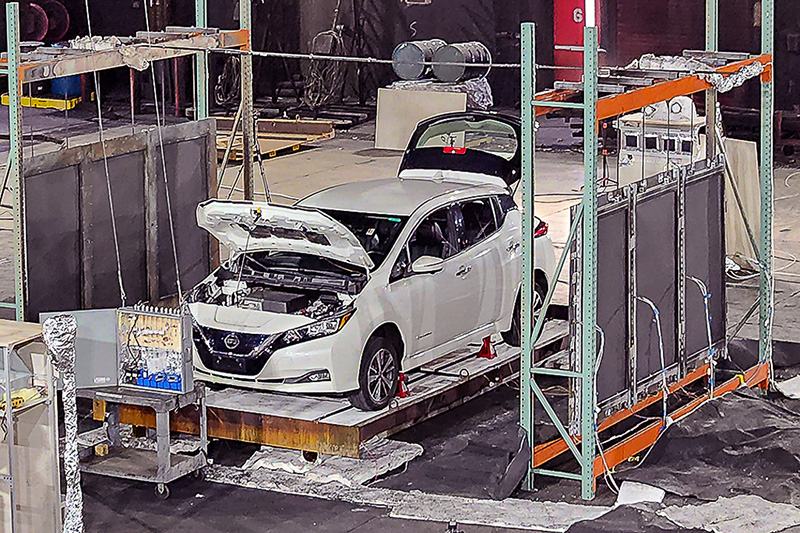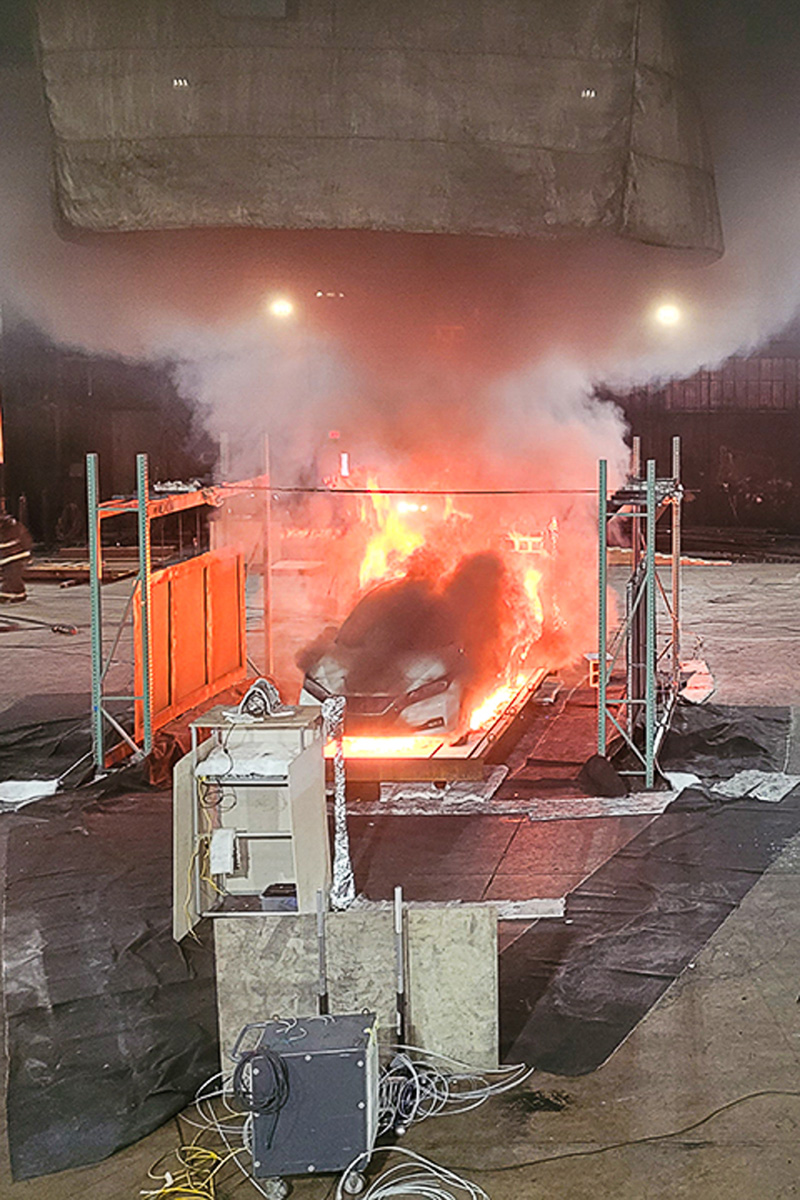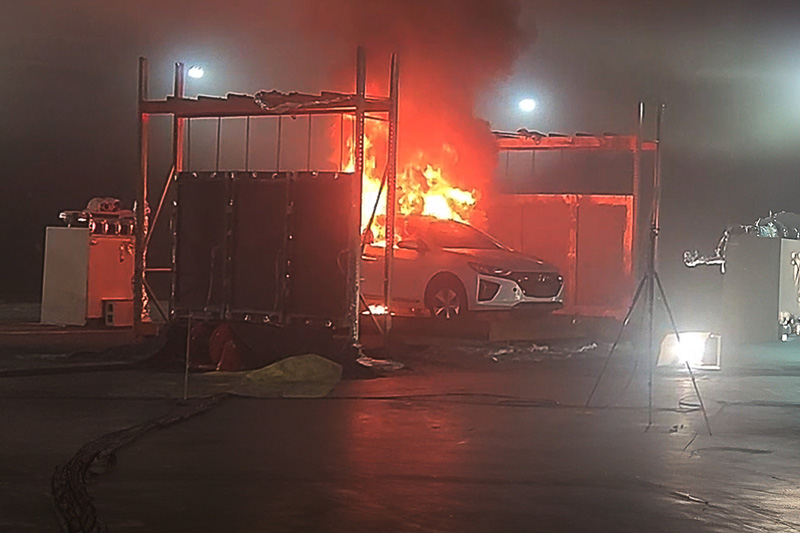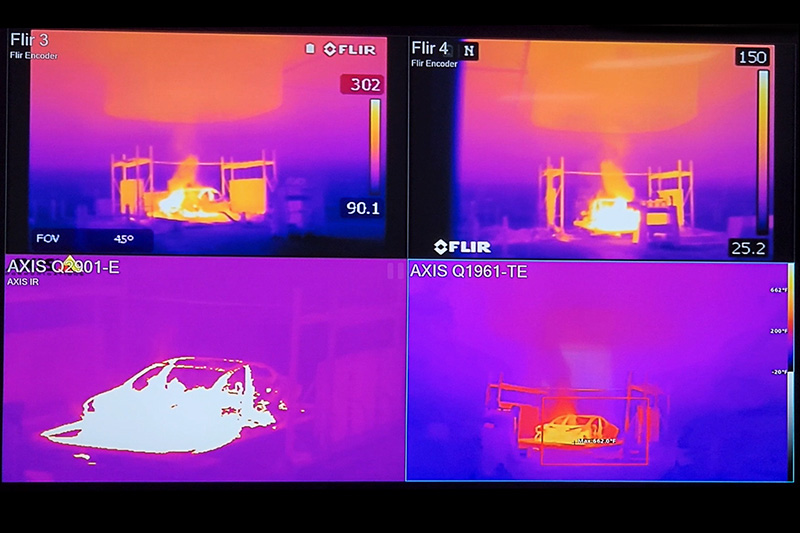BY Patrick Durham, representing FSRI EV technical panel
In the ever-changing landscape of transportation, electric vehicles (EVs) signify a shift toward innovative progress. However, this innovation brings its own set of challenges, especially concerning EV fires. Firefighters confront a unique and multifaceted challenge when dealing with EV incidents.
- The Rules of Engagement for Electric Vehicle Battery Fires
- Training Minutes: Electric Vehicle Hazards
- EV Size-Up and Thermal Runaway: Lucid Air
This article explores the concerns and uncertainties surrounding EV fires, looking into the intricacies of firefighting efforts and the potential long-term effects on the health and safety of those on the front lines. As fire departments grapple with the complexities of extinguishing EV fires and the risks of chemical exposures, ongoing research by the Fire Safety Research Institute (FSRI) takes the spotlight, promising valuable insights into the hazards of EVs and laying the foundation for enhanced safety protocols.
FSRI has assembled a formidable technical panel comprising 17 experts for its three-year research project. This diverse group includes professionals from the auto industry, firefighters, and researchers, ensuring a comprehensive and multifaceted approach to the study. Currently in its second year, the project commenced with a meticulous planning phase and the development of precise test procedures.
This ambitious initiative, with an annual cost estimate of approximately $1 million, is made possible through funding from an endowment secured by FSRI. The financial backing underscores the commitment to advancing understanding and safety measures surrounding EV fires. As the project progresses, the collective expertise of this diverse panel is poised to yield valuable insights, contributing significantly to the enhancement of safety protocols for both firefighters and the broader community.

1. Experimental test setup in the large-scale fire lab in Northbrook, Illinois. (Photos by author.)

2. The early stages of fire development in the experiment in Northbrook, Illinois.
Laying the Groundwork
In laying the groundwork for the study, FSRI commenced by burning an internal combustion engine (ICE) vehicle. This deliberate choice was made to establish a baseline dataset before investigating the complexities of EV fires. Building this foundation is essential for conducting comprehensive research and developing effective safety protocols applicable to both types of incidents. Understanding the dynamics of ICE vehicle fires is a crucial precursor to unraveling the intricacies posed by EV fires.
Historically, there has been a lack of significant concerns from the fire service regarding conventional vehicle fires. There is surprisingly little research that has been conducted in this area. Typically perceived as straightforward incidents, and a step up from a dumpster fire, these fires usually involve the use of approximately 200 gallons of water and require minimal time on the scene.
EV and ICE Vehicle Fire Experiments
The initial burn involving the ICE vehicle was successfully conducted in December 2023. Following this milestone, in February 2023, a series of tests were completed involving six EVs. These rigorous experiments took place at UL Solutions expansive fire lab located in Northbrook, Illinois—a facility renowned for its previous large-scale structure fire tests conducted by FSRI.
These tests focused on nonintervention scenarios, allowing the EVs to burn completely to gather comprehensive data. The deliberate decision to let the vehicles burn allowed a full set of data to be collected. These crucial tests mark significant progress in the ongoing three-year project initiated by the FSRI (photos 1 and 2).
Under the leadership of research engineer Adam Barowy, a team of researchers and technicians are diligently working on the EV fire study. Operating within the constraints of limited lab availability, the team is navigating numerous complexities and is extremely dedicated.
The ICE vehicle, tested with a full tank of gas, provided the baseline for comparison. The EVs were tested at 100% state of charge. The researchers carefully collected a significant amount of data throughout the burn process using an array of techniques.

3. Remnants of cylindrical battery cells following the Tesla fire.

4. Visibility diminishes as the lab fills with smoke, blanketing the experimental setup.

5. Peering through the dense smoke after the lab plunges into zero visibility, captured through the lens of thermal imaging cameras.
Detailed Experimentation Process
- Temperature data was gathered through numerous thermocouples, both inside and outside the vehicles.
- Two large walls flanking each side of the vehicle measured the radiant heat from the fire, simulating potential scenarios where a neighboring vehicle might catch fire.
- Air samples were taken around the vehicle to assess firefighter exposure, and samples were also collected in the plume of smoke above the vehicle to identify the chemicals present.
- The vehicles were placed on a special scale, allowing for monitoring mass loss during the fire. This allowed researchers to determine the heat release rates during the fire.
- A pan was strategically placed under the vehicles to collect water runoff, helping assess potential contamination.
- The unconventional approach involves not extinguishing the vehicle but instead wetting it down at the end of the test to contaminate the water.
- Swatches of turnout gear around the vehicle provide crucial insight into the type of contamination that may occur after exposure.
- To ignite the vehicle, a propane burner was positioned under the vehicle.
- For the ICE vehicle, the burner was placed under the engine compartment, and it was placed under the high-voltage battery for the EVs.
- Once the fire became self-sustaining, the burner was turned off, allowing the researchers to observe and collect valuable data during the burn process.
While this detailed experimental process aims to provide comprehensive insights into the hazards posed by EV fires, it will also offer the fire service valuable information on ICE vehicle fires, a topic that has received little research attention in the past. This contribution aids in the development of informed safety protocols for firefighters (photos 3-5).
The National Institute for Occupational Safety and Health (NIOSH) was also involved in the research on EV fires. NIOSH’s role in the experiment includes the substantial collection of particulate matter from the air, along with pans strategically placed on the ground to gather soot. This valuable material will be instrumental in NIOSH’s subsequent study specifically focusing on the biological effects of contamination on firefighters.
By specifically looking into the impact of these unique fire scenarios on the health and well-being of first responders, NIOSH enhances the scope of the overall research effort. The collaboration between FSRI and NIOSH not only deepens our understanding of the immediate challenges posed by EV fires but also addresses the long-term implications for the individuals on the front lines of emergency response.
Observations
Having observed both the ICE vehicle experiments and the EV experiments, some striking patterns have emerged. One notable observation is the substantial presence of plastic and composite materials in both vehicle types. This composition results in a highly sooty fire with dense smoke, creating challenging conditions for the lab environment.
During both types of fires, the significant amount of plastic and composite materials led to a pronounced reduction in visibility within the lab. Despite the building’s exhaust system being in operation to remove smoke during the fire, the visibility still plummeted to zero. This finding underscores the severity of the smoke produced during these vehicle fires, highlighting the importance of wearing full PPE with SCBA during any incident involving a vehicle fire.
Insights and Next Steps
The upcoming phase involves a comprehensive analysis of all the collected data. Here are next steps:
- The technical panel, in collaboration with FSRI staff, will convene to discuss their observations.
- Anticipated in the third quarter of 2024, a preliminary report will be released, providing initial insights into the findings.
- Subsequent decisions will be made collaboratively on how to proceed with the next set of experiments.
- These forthcoming experiments will involve intentionally starting an EV on fire and then evaluating various extinguishing methods.
- The aim is to establish a set of guidelines that can be valuable for firefighters in managing future incidents involving EV fires.
The ongoing three-year study led by the FSRI represents a pivotal effort in understanding the complex challenges associated with EV fires. The meticulous research undertaken by FSRI not only sheds light on the hazards associated with EVs but also emphasizes the importance of continuous improvement in safety protocols. By combining hands-on experiments, data analysis, and collaboration among experts, the study will significantly contribute to the evolving landscape of firefighting practices in the context of EV incidents. Ultimately, this research endeavor underscores a proactive and informed approach to ensuring the safety of both first responders and the broader community in the face of emerging challenges in transportation technology.
REFERENCES
“Experiments Enabling Analysis of Electric Vehicle Fire Behavior are Completed.” FSRI, 22 May 2024. bit.ly/3wWR8F2.
“Technical Panel for Fire Safety of Batteries and Electric Vehicles Holds First Meeting.” FSRI, 31 May 2023. bit.ly/45mGq7p.
PATRICK DURHAM is a captain and training officer in the Troy (MI) Fire Department. He is a mechanical engineer, engaged in cutting-edge automotive industry projects. Notably, he has been involved in designing innovative multi-material battery structures for EVs. Drawing from more than 15 years of combined experience as a firefighter and an engineer, Durham has developed specialized training courses for firefighters focusing on various technical aspects, including the specific challenges associated with responding to incidents involving EVs. Durham is also a member of the Technical Panel for Fire Safety of Batteries and EVs at the Fire Safety Research Institute, where he contributes his expertise to advance the field of fire safety in the context of emerging battery technologies and EVs.

